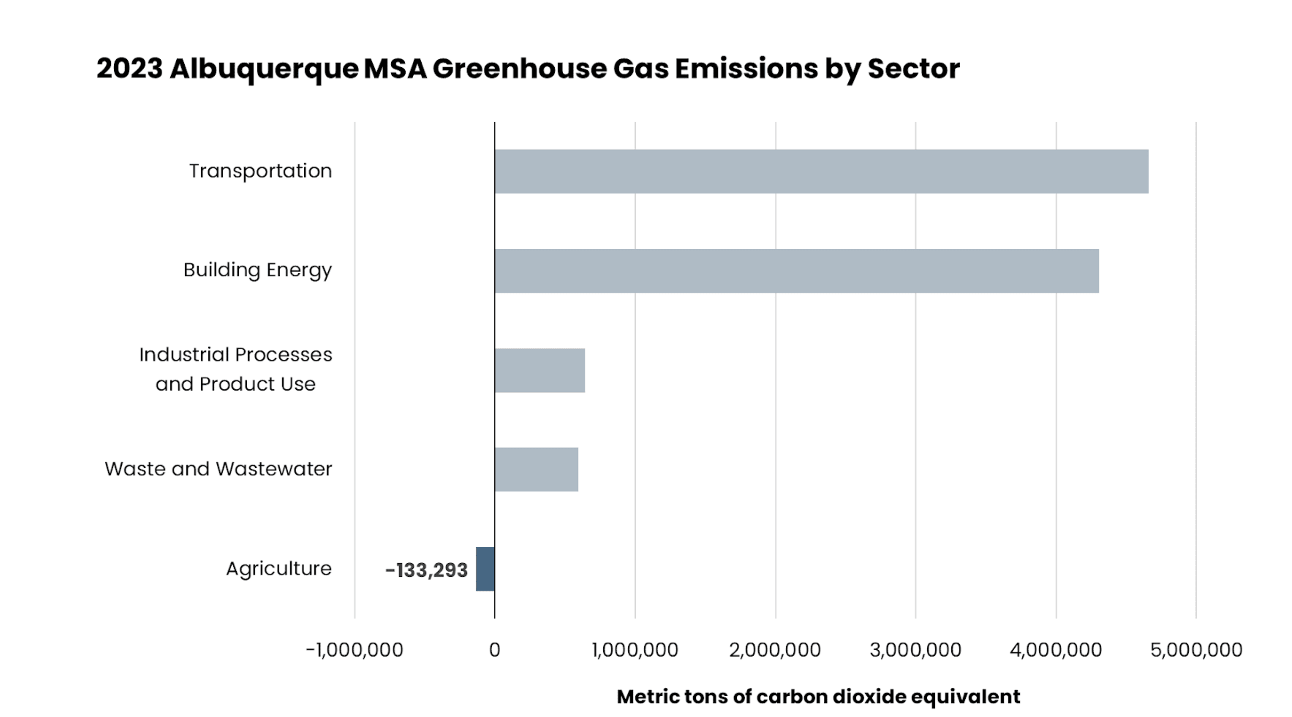
Agriculture and Working Lands
Introduction
Central New Mexico has a long history of agriculture and strong land management practices. Land use issues present both a great threat and a great opportunity to achieve climate goals. The region consists of both sources and sinks of Carbon emissions. Aligning work on climate change, land conservation, and restoration is an opportunity to utilize local carbon sinks to benefit multiple efforts. Sinks, or removals of carbon, are associated with the natural carbon cycle of Trees and Forests in the region. All lands have the potential to sequester carbon from the atmosphere and store it in plant material, including the ecosystems that make up the Albuquerque MSA.
Due to the significant amount of the dense forests and grasslands in the Albuquerque MSA, three of the four counties in the region have effectively captured more carbon from forestry and trees than emitted in the agricultural sector. The land use types have stayed relatively constant in the region, with Agricultural, Grazing, Forestry, and Recreation being the dominant land use types. However, land management practices have changed in the last century. Livestock are more confined than in the past, and forestry has had limited natural fires, creating more dense forests, but also more fire susceptible.
In 2023, greenhouse gas (GHG) emissions from agriculture (livestock and fertilizer) totaled nearly 350,000 mt CO2e pollution in the Central New Mexico. Livestock emissions make up 99% of the total while fertilizer accounts for the remaining 1%. While agriculture has created emissions, land use practices have resulted in a carbon sink of approximately 482,000 mtCO2e for the MSA. This information can be seen in Figures 1 and 2 below.
This graph displays the total greenhouse gas emissions across various sectors in 2023, measured in metric tons of carbon dioxide equivalent:
Transportation: Over 4 million metric tons.
Building Energy: 4,304,242 metric tons.
Industrial Processes and Product Use: Moderate contributor, shown below Building Energy and Transportation.
Waste and Wastewater: 590,047 metric tons.
Agriculture: Net reduction of -133,293 metric tons, indicating carbon sequestration.
This graph shows carbon emissions and sequestration (negative emissions) from different agricultural sources in the Albuquerque MSA for 2023. The values are measured in metric tons of carbon dioxide equivalent.
Livestock: Emissions total 345,713 metric tons.
Fertilizer Application: Emissions total 3,090 metric tons.
Forestry and Trees: Shows a net sequestration of -482,096 metric tons, meaning these activities reduce overall emissions.
Bright spots
The region’s ability to remove carbon is worth noting, especially for an arid and high-elevation part of the country. Carbon removal has effectively balanced out emissions from agriculture.
What you can do
Agriculture and Land Use are primarily managed at a larger scale than an individual of community.
Consider adapting farming practices where possible, to reduce tilling, fertilizer use, and water-intensive crops.
Support local and smaller farms.
Become informed about Agriculture and Land Use decisions in your region. Similar mountain communities have utilized “tree thinning” as a necessary tactic to ensure resilience in forested areas. While lessening the number of trees and their potential to remove and sequester carbon, tree thinning offers the advantage of lessening catastrophic impacts from fire that not only emit carbon, but can have long term effects on the land’s ability to revegetate and return to a forest.



